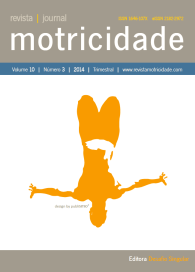The impact of individual characteristics on maintaining physical activity programs in a fitness gym
DOI:
https://doi.org/10.6063/motricidade.1861Abstract
The study examined the impact of individual characteristics (gender, age, BMI, body fat percentage) and monthly frequency of practice on regular access to the gym. Anthropometric measures of 1573 subjects of both sexes (male: n = 840; age 32.5 ± 8.9 years) were assessed at the beginning of the exercises program. The Average Monthly Frequency (AMF) was calculated based on access control, being computed only one access/day. We defined "regular" the individual staying in the gym for six months (or more) consecutive. The impact of the characteristics on regularity was determined by a multiple logistic regression model. Age and AMF were associated with high probability of regularity. Taking as reference individuals up to 25 years, within age between 26 and 45 showed higher chances to be regular (OR: 1.67, 95% CI 1.19 to 2.34, p= 0.003), as well as those above 45 years (OR: 3.28, 95% CI 1.99 to 5.42, p<0.001). AMF equal to or higher than eight days showed 50% of probability to be regular, regardless of age. It is concluded that individual characteristics can be selected for the detection of individuals that are more likely to abandon exercises programs and to prevent dropout.Downloads
Published
Issue
Section
License
The authors of submitted manuscripts must transfer the full copyright to Journal Motricidade / Desafio Singular Editions. Granting copyright permission allows the publication and dissemination of the article in printed or electronic formats and copyrights start at the moment the manuscript is accepted for publication. It also allows Journal Motricidade to use and commercialize the article in terms of licensing, lending or selling its content to indexation/abstracts databases and other entities.
According to the terms of the Creative Commons licence, authors may reproduce a reasonable number of copies for personal or professional purpose but without any economic gains. SHERPA/RoMEO allows authors to post a final digital copy (post-printing version) of the article in their websites or on their institutions' scientific repository.


